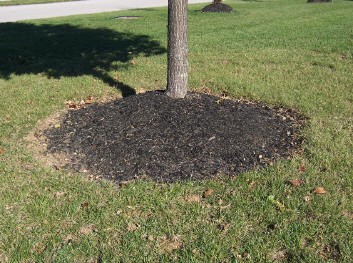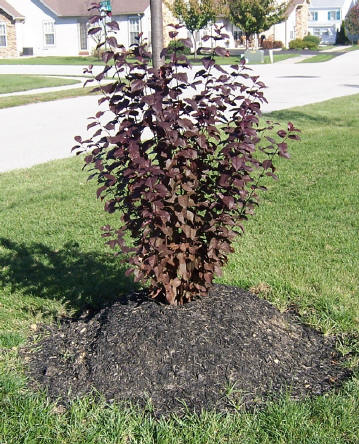|
No More Mulch Volcanoes, Please!
Susan Trice
Frederick County Gardener Coordinator
As I write my first article for this paper as the University of Maryland Cooperative Extension Horticulture Educator, I asked myself what is
my number one target for discussion that needs to be addressed. That subject came quite quickly to me. It's 'Mulch Volcanoes'. And what a good time to discuss them, as it is
Fall and gardeners everywhere are perhaps sprucing up their properties, protecting the tender plants, adding trees and/or shrubs, mowing the grass after some much needed rain
and hopefully mulching the leaves, and whatever else needs to be done to see them through the winter.
 Never heard of a 'mulch volcano'? It a term being given to the pile
of mulch around the base of a tree to form what looks like a volcano as it angles up the tree trunk. The only thing oozing as a result of these volcanoes perhaps are sap from
the trees once borers get into them or disease takes over. Applying mulch too thickly will invite insects, disease, fungi and small rodents. Never heard of a 'mulch volcano'? It a term being given to the pile
of mulch around the base of a tree to form what looks like a volcano as it angles up the tree trunk. The only thing oozing as a result of these volcanoes perhaps are sap from
the trees once borers get into them or disease takes over. Applying mulch too thickly will invite insects, disease, fungi and small rodents.
Let it be known that mulch, particularly for young or newly planted trees, is good for the plants. It provides plants with a constant supply
of oxygen, keeps the soil at a more even temperature, prevents weed growth, conserves moisture, over time adds organic matter to the soil if in deed using organic mulch,
reduces soil erosion, improves aesthetic values and most likely adds value to the landscape property.
The proper way to mulch a tree or shrub after planting them at the proper depth is to apply 2-4" over the entire root system of the plant.
Keep mulch at least 6" from the base of a trunk. Some prefer to start tapering off when they reach within a foot of the trunk. You should see the flare at the bottom of the
trunk. If you already have mulch and roots have not begun to growth within in it, just pull if away from the trunk and use that extra supply elsewhere.
 Perhaps you saw it being done by others and thus find it
acceptable. I assure you it isn't being promoted by 'Certified Professional Horticulturists' who are certified through the Maryland Nurserymen's Association, because I am one
myself and have read the manual. You also won't find it in the ever popular nationally used high school horticulture textbook "Introductory Horticulture' written by Dr.
Carroll Shry Jr., Horticulture Instructor at the Career Technical Center, right here in Frederick, Maryland, and the late Ed Reiley. And you certainly won't see it being done
or recommended by a Master Gardener. Perhaps you saw it being done by others and thus find it
acceptable. I assure you it isn't being promoted by 'Certified Professional Horticulturists' who are certified through the Maryland Nurserymen's Association, because I am one
myself and have read the manual. You also won't find it in the ever popular nationally used high school horticulture textbook "Introductory Horticulture' written by Dr.
Carroll Shry Jr., Horticulture Instructor at the Career Technical Center, right here in Frederick, Maryland, and the late Ed Reiley. And you certainly won't see it being done
or recommended by a Master Gardener.
I did a little research on this and can only guess that it was a result of someone planting trees too high above the ground and then adding
mulch on top of it. I can find these planted in my own development. For helpful advice on this and other 'Common Abiotic Plant Problems' go to www.hgic.umd.edu and download
the free publication HG86. While you are there, why not browse a while to discover this rich source of information.
I wish you much pleasure as you enjoy your garden throughout the year. Now go out there and check to see that your mulch is at the proper
depth and away from the trunk. Make those volcanoes a thing of the past. Your plants will thank you and I thank you.
For more information about horticulture or the Master Gardener Program in Frederick County, call the Frederick County Office of the Maryland
Cooperative Extension, (301) 600-1596, or visit http://extension.umd.edu/local/frederick. Our mission is to educate Maryland residents about safe, effective and sustainable
horticultural practices that build healthy gardens, landscapes and communities.
Read other articles on gardening techniques
Read other articles by Susan Trice
|